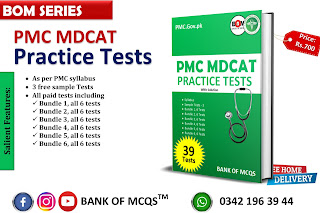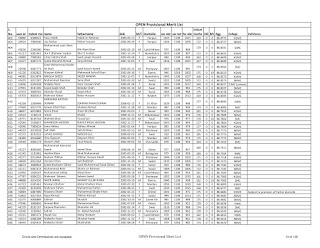Chap.21 Inheritance MCQs
|
1. |
|
|
|
2. |
Transmission
of genes governing various characters from parents to offspring (a)
Inheritance (b) Trait (c)
Variation (d) None of
these |
A |
|
3. |
It's
the basic unit of biological information (a)
Genotype (b) Phenotype (0)
Allele (d) None of
these |
A |
|
4. |
Position
of a gene on a chromosome is called: (a)
Focus (b) Locus (c)
Alleles (d) None of
these |
B |
|
5. |
The
two members of a gene pair are called. (a)
Traits (b) Gene
pool (c)
Alleles (d) None of
these |
C |
|
6. |
It
is the form of appearance of a trait. (a)
Pleiotropy (b) Phenotype (c)
Genotype (d) None of
these |
B |
|
7. |
Plant
used by Mendel in his experiments was (a)
Pisum Satirum (b) Triticum (c)
Oryza Sativa (d) None of these |
A |
|
8. |
The
cross of a phenotypically dominant individual with its recessive is called? (a)
Test Cross (b) Monohybrid
Cross (C)
F1Cross (d) None of
these |
A |
|
9. |
The
chance of an event to occur is called: (a)
Paleography (b) Probability (c)
Epiphysis (d) None of
these |
B |
|
10. |
A
hybrid red flower (Rr) is crossed with a white flower. What %age of the
offspring will be
red? (a)
0% (b) 25% (c)
50% (d)
75% |
A |
|
11. |
A
red flower is crossed with a white flower and all the offspring are pink.
Which law of inheritance does this follow? (a)
Dominance (b)
Segregation (c)
Incomplete Dominance (d)
Co-dominance |
C |
|
12. |
Which
of the following crosses best demonstrates the law of segregation?. (a)
AA x aa (b) aa x aa (e)
Aa x aa (d) Aa x Aa |
A |
|
13. |
A
couple has two children. One child has blood type A and the other has blood
type O. What are all the possible blood types of the parents? (a)
Either both have type A or one has type A and other has type O or one has A
and the other has type B (b)
There is only one possibility, both parents have type A blood (c)
There is only one possibility, both parents have type O blood (d)
There is only possibility, one parent has type A and the other has type o |
D |
|
14. |
Which
is true about blood type? (a)
Type A is dominant over type B (b)
Type B is dominant over type A (c)
Type AB is dominant over both A and B (d)
Types A and B are dominant over type O |
D |
|
15. |
A
man with haemophilia marries a woman who has normal haemoglobin and is not carrier?
Which of the following is true? (a)
None of their children will have the disease nor will they be carriers (b)
All the boys will have the disease (c)
All the girls will have the disease (d)
All the girls will be carriers |
D |
|
16. |
If
a man is colour-blind and his wife is a carrier, which of the following is
true? (a)
Each girl has a 50% chance of being colour - blind (b)
No girl will be colour- blind because girls cannot be colour-blind (c)
All the boys will be carriers (d)
All the girls will be carriers |
A |
|
17. |
A
test cross is done to: (a)
Determine if cross over has occurred (b)
Prevents sex-linked traits from being passed on (c)
Determine if an organism exhibiting the dominant phenotype is carrying a
recessive Allele for that trait (d)
Prevents cross over from occurring |
C |
|
18. |
A
farmer planted 1,000 seeds of corn. The offspring were 544 tall with yellow
seeds, 188 tall
with green seeds, 183 short with yellow seeds and 64 short with green seeds.
What were
the genotypes of the parents?. (a)
TTYY tyy (b) TYy TYY (c)
TYy tyy (d) ttyy tyy |
A |
|
19. |
Chances
for a son or daughter in human birth are: (a)
3:1 Between Son and Daughter (b)
1:3 Between Son and Daughter (C)
1:1 Between Son and Daughter (d)
None of these |
C |
|
20. |
The
number of linkage groups in man is: (a)
02 (b) 23 (C)
46 (d) 92 |
C |
|
21. |
A
man of blood group A marries a woman of blood group B and they have one
child. Which one of the following statements about the child's blood is
correct? (a)
It could be group A only (b)
It could be group AB only (c)
It could be group A or group B only (d)
It could be any of the groups A, B. AB, O |
D |
|
22. |
How
many different kinds of gametes will be formed by an individual, who is
heterozygous for
four gene pairs? (a)
8 (b) 16 (c)
20 (d) 30 |
B |
|
23. |
A
woman with normal colour vision whose father was red-green blind, married a
red green
colour-blind man. What is the probability of her first-born child being red green
colour blind? (a)
1.0 (b) 0.75 (c)
0.50 (d)
0.025 |
B |
|
24. |
Two
parents each of blood groups A, have a daughter of blood group O. What is the probability
that their next child has blood group O? (a)
0.125 (b) 0.25 (c)
0.50 (d)
0.75 |
B |
|
25. |
What
are the phenotypes of the parent of a colour blind son and non-carrier
daughter with
normal colour vision? FATHER MOTHER (a)
Carrier Normal (b)
Colour Blind Carrier (C)
Normal Carrier (d)
Normal Colour Blind |
D |
|
26. |
When
expression of a biological character is observed in variable intensity, it is
due to the effect
of: (a)
Multiple Alleles (b) Co-dominance. (c)
Epistasis (d) Polygenic
inheritance |
D |
|
27. |
Inheritance
of skin colour in man is controlled by eight pairs of genes which are: (a)
Linked (b)
Co-dominant (c)
Multiple alleles (d) Assorting
independently |
D |
|
28. |
Baldness
is a: (a)
Sex related trait (b) Sex limited
trait (c)
Sex influenced trait (d) None
of these |
C |
|
29. |
All
of the following are examples of x-linked recessive disorders except: (a)
Colour Blindness (b) Diabetes
Insipidus (e)
Haemophilia (d)
Alport's Syndrome |
D |
|
30. |
Holandric
inheritance is related to the inheritance of gene present on: (a)
X-Chromosome (b) Y-Chromosome (c)
Autosome (d) None of these |
B |
|
31. |
SRY
gene on Y- chromosome of man determines: (a)
Height (b) Skin
Colour (c)
Haemophilia (d) Maleness |
D |
|
32. |
In
drosophila, the gene for eye colour is associated with: (a)
Autosome (b) X-Chromosome (c)
Y-Chromosome (d) Both b and c |
B |
|
33. |
T.H. Morgan made the first demonstration of a
sex-linked trait in (a)
1941 (b) 1930 (c)
1910 (d) 1859 |
C |
|
34. |
XXY
set of chromosomes in drosophila produces a fertile: (a)
Male (b) Female (c)
Both of these (d) None of these |
B |
|
35. |
WZ-ZZ
type of sex-determination pattern was discovered in 1914 by (a)
Morgan (b) Mendel (c)
Sieler (d) Haeckel |
C |
|
36. |
Map
units are often called: (a)
Linkage groups (b) Centimorgans (c)
Recombinants (d) None of these |
B |
|
37. |
A
gamete without any sex chromosome is called: (a)
Recombinant (b) Mutant (c)
Nullo Gamete (d) Wild Type |
C |
|
38. |
The
proportion of recombinant types between two gene pairs as compared to the sum
of all combinations is called: (a)
Crossing over (b)
Gene linkage (c)
Recombination frequency (d)
Mutation |
C |
|
39. |
Farther
apart two genes, the probability that a cross over will occur will be: (a)
Higher (b) Lower (c)
Equal (d) None of
them |
A |
|
40. |
As
a result of a test cross, there will be no linkage between the genes if: (a)
All four phenotypic combinations (parental and recombinants) are produced in
equal 1:1:1:1 ratio (b)
are parental types and less recombinant types (c)
Only parental types are produced (d)
Only recombinant types are produced |
A |
|
41. |
In
human, genes for sickle cell anemia, Leukemia and albinism are found on chromosome (a)
9 (b) 11 (c)
22 (d)
X-Chromosome |
B |
|
42. |
The
following is an example of polygenic inheritance (a)
Height (b) Weight (c)
Intelligence (d)
All of these |
D |
|
43. |
The
Bombay phenotype in human is an example of: (a)
Pleiotropy (b) Polygenic
Inheritance (c)
Linkage (d) Epistasis |
D |
|
44. |
In
case of Bombay phenotype, individuals are genotypically like A, B or AB but phenotypically
are: (a)
A (b) B (C)
AB (d) O |
d |
|
45. |
When
the immune response of the mother against the Rh factor has already been
exposed and
her antibodies can cross the placenta and destroy the red blood cells of
Rh-positive foetus, this condition is referred as: (a)
Immunosuppression (b)
Erythroblastosis fetalis (c)
Transfusion (d)
Anemia |
B |
|
46. |
Blood
group system other than "ABO" and "Rh" are: (a)
MNS (b) Kell (c)
Lutheran (d) All of
these |
D |
|
47. |
The
genetic basis of ABO blood system was explained
in 1925 by:. (a
Landsteiner (b) Bernstein (c)
Sturtevant (d) Sutton |
B |
|
48. |
The
gene "I" of "ABO" blood groups is present on: (a)
Chromosome 11 (b)
Chromosome 9 (c)
X-Chromosome (d)
Y-Chromosome |
B |
|
49. |
Tongue
rolling in human is controlled by a single: (a)
Recessive Gene (b) Dominant Gene (c)
Polygene (d) None of
these |
B |
|
50. |
Both
genotypic and phenotypic ratios are the same in case of: (a)
Co-dominance (b) Over
Dominance (c)
Incomplete Dominance (d) Complete
Dominance |
A |
|
51. |
Alkaptonuria
is an inborn biochemical disorder in which the person excretes: (a)
Albumen (b) Homogentisic
Acid (c)
HCL (d) Acetic
Acid |
B |
|
52. |
If
a tall plant is crossed with a dwarf planet, the cross is called: (a)
Test Cross (b) Back Cross (c)
Monohybrid Cross (d) Dihybrid Cross |
C |
|
53. |
Segregation
of alleles occurs at the time of: (a)
Cleavage (b) Meiosis (c)
Fertilization (d)
Crossing over. |
D |








Comments
Post a Comment